- Home
- Musky
What do Pike Eat?

Fishing for pike is a popular pastime for many anglers, but knowing what these predatory fish eat can make all the difference in catching them.
Pike are opportunistic feeders and will consume a wide variety of prey items depending on their size, location, and other factors. In this article, we will explore the diet of pike in detail, from their primary prey to less common items, and how their diet can change throughout the year.
So, whether you are a seasoned pike angler or just starting out, understanding what pike eat can help you land more fish and have a more successful day on the water.
What do Pike Eat?
- Perch
- Shad
- Trout
- Panfish
- Minnows
- Frogs
- Ducklings
Pike Diet Overview
Pike are carnivorous fish that feed primarily on other fish, although they will also eat small mammals, birds, and invertebrates. They are ambush predators and will often wait patiently for their prey to swim by before striking quickly and swallowing them whole.
The size of the prey that a pike will consume is largely determined by its own size – larger pike will consume larger prey, while smaller pike will feed on smaller prey.
The diet of pike can vary depending on a number of factors, including the location of the fish, the time of year, and the availability of prey.
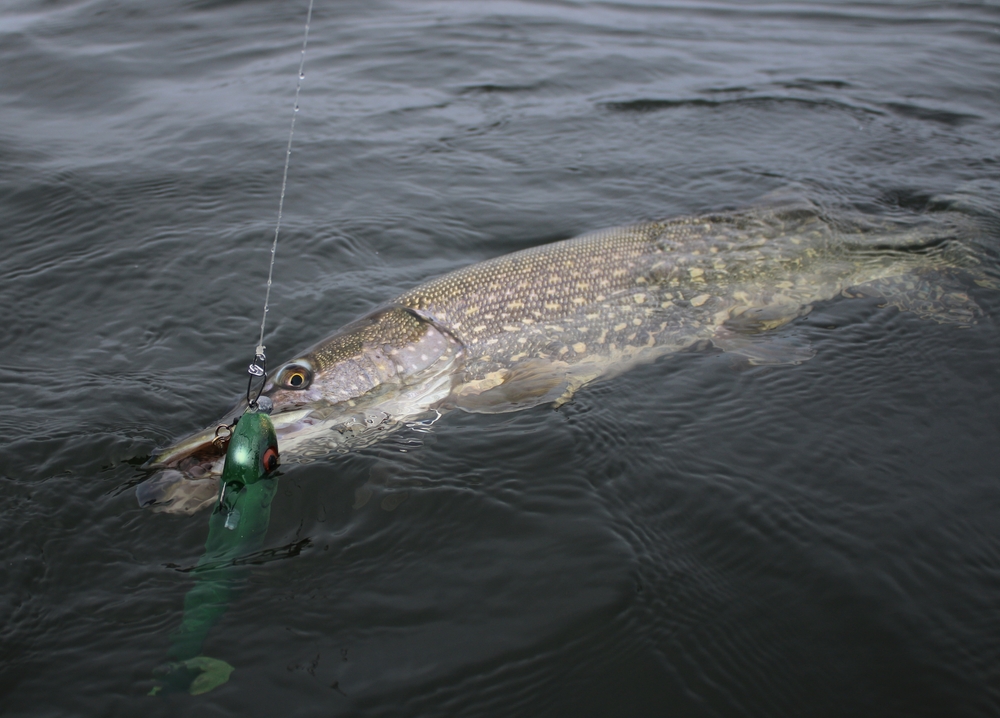
Pike in different regions may have access to different prey species, and they may adjust their diet depending on what is available to them. For example, pike in a lake with a large population of perch may primarily feed on perch, while pike in a river with a lot of minnows may eat mostly minnows.
Overall, pike are opportunistic feeders that will eat a wide range of prey items depending on the circumstances. Understanding their primary prey and how they hunt and consume them is essential for successful fishing.
Primary Prey
The primary prey of pike includes other fish such as perch, crappie, walleye, trout, and other small fish species. Pike prefer to feed on fish that are smaller than themselves, but they have been known to take fish up to half their own size or even larger in some cases.
Pike are ambush predators, and they use their sharp teeth and powerful jaws to strike and swallow their prey whole. They often hunt near structures such as weed beds, submerged logs, and drop-offs where prey fish are likely to be hiding or swimming by.
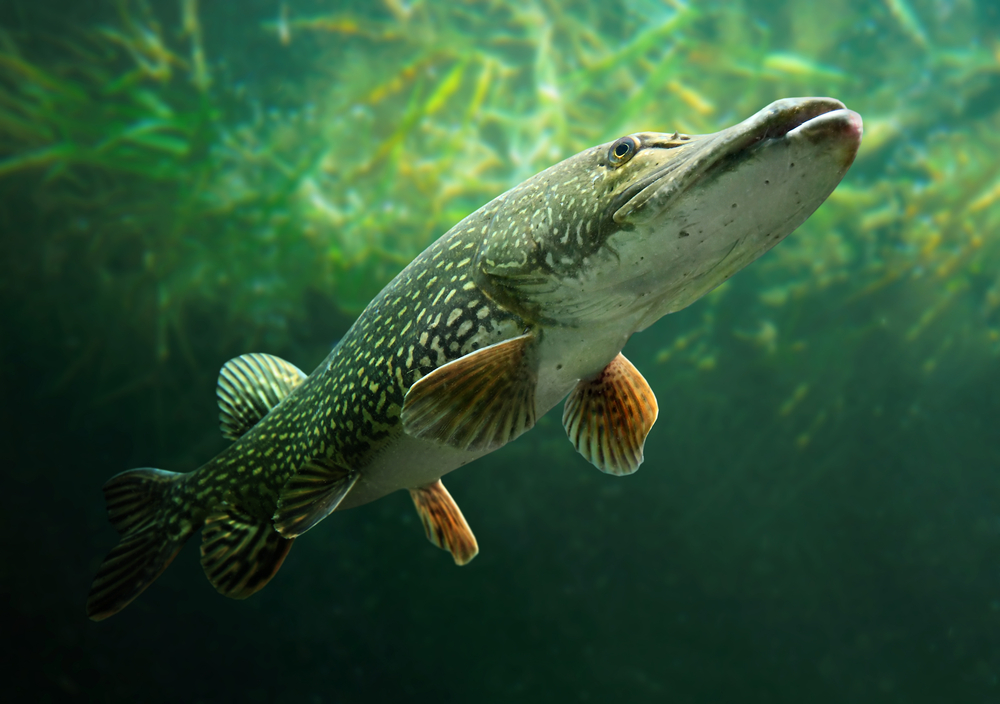
When hunting, they will often use their lateral line to detect the vibrations caused by the movements of nearby fish.
Some of the most common prey fish for pike include:
- Perch: Pike and perch are often found in the same waters, and pike are known to feed heavily on perch, especially smaller ones.
- Panfish: Pike will eat panfish such as bluegill, sunfish, and crappie if they are present in their habitat.
- Walleye: Pike will eat young walleye but less often that perch or other small species.
- Trout: Pike will eat trout but only smaller trout in shallower waters.
Understanding the behavior of these primary prey species and how pike hunt and consume them is crucial for successful fishing. By using lures or live bait that mimic the movement and appearance of these prey items, anglers can increase their chances of catching pike.
Uncommon Prey
While pike primarily feed on other fish, they have been known to consume a wide range of other prey items as well. Some of these less common prey items include:
- Waterfowl: Large pike have been known to take waterfowl such as ducks and coots when they are swimming on the water’s surface. This behavior is more common in northern regions where waterfowl populations are high and pike have fewer prey options.
- Frogs: Pike will sometimes eat frogs that are swimming near the surface of the water or resting on vegetation. Frogs are more commonly eaten by smaller pike, but larger ones have been known to take them as well.
- Small Mammals: In some cases, pike have been known to consume small mammals such as mice and voles that are swimming or crossing the water. This behavior is rare, but it has been observed in certain regions.
- Invertebrates: While pike primarily feed on fish, they will also consume invertebrates such as crayfish, snails, and insects when other prey options are limited.
Understanding these less common prey items and the situations in which pike may consume them can be useful for anglers who are looking to try new tactics or experiment with different types of bait. However, it’s important to remember that pike primarily feed on fish and that targeting their primary prey is usually the most effective way to catch them.
Seasonal Changes
The diet of pike can change throughout the year as a result of seasonal changes in water temperature, water level, and prey availability. Understanding how these changes affect the feeding habits of pike can be helpful for anglers who are looking to target them at different times of the year.
In the spring, when the water is warming up and the ice is melting, pike will become more active and start feeding more heavily. They may feed on smaller prey items such as minnows and insects that are more abundant during this time. As the water temperature continues to rise, larger prey items such as perch and roach become more active, and pike will start to feed on them more frequently.
During the summer months, when the water is at its warmest, pike may become less active and feed less frequently. They may still feed on smaller prey items, but they may also become more selective and prefer larger prey items that are more energy-efficient to catch. As the water temperature cools down in the fall, pike will become more active again and start feeding more frequently.
In the winter, when the water is coldest and the ice has formed, pike will become less active and feed less frequently. However, they may still feed on smaller prey items such as minnows and invertebrates that are active under the ice.
Overall, the feeding habits of pike can change throughout the year depending on a variety of factors. By understanding these changes and adjusting their tactics accordingly, anglers can increase their chances of catching pike at different times of the year.
Conclusion
In conclusion, understanding what pike eat and how their diet can change throughout the year is essential for successful fishing.
Pike are primarily fish eaters, and their diet includes a variety of prey items such as perch, roach, rudd, and bream. However, they have also been known to consume less common prey items such as waterfowl, frogs, and small mammals.
Seasonal changes in water temperature, water level, and prey availability can also affect the feeding habits of pike, and anglers who are looking to target them at different times of the year should adjust their tactics accordingly.
Overall, by understanding the feeding habits of pike and using tactics that mimic their primary prey, anglers can increase their chances of catching these predatory fish. So, whether you are a seasoned pike angler or just starting out, knowing what pike eat can help you land more fish and have a more successful day on the water.
What do Musky Eat?

Fishing for Musky, also known as muskellunge, is a popular sport among anglers. These large, aggressive fish can provide a thrilling challenge for even the most experienced fishermen. However, in order to successfully catch Musky, it’s important to understand their diet.
Knowing what Musky eat can help anglers choose the right lures and fishing techniques to increase their chances of success. In this article, we’ll provide an overview of Musky’s diet and offer tips for catching these elusive fish.
Musky Diet Overview
Musky are at the top of the food chain in their ecosystem and are considered apex predators. They are known for their large size, aggressive behavior, and ability to hunt down a wide variety of prey.
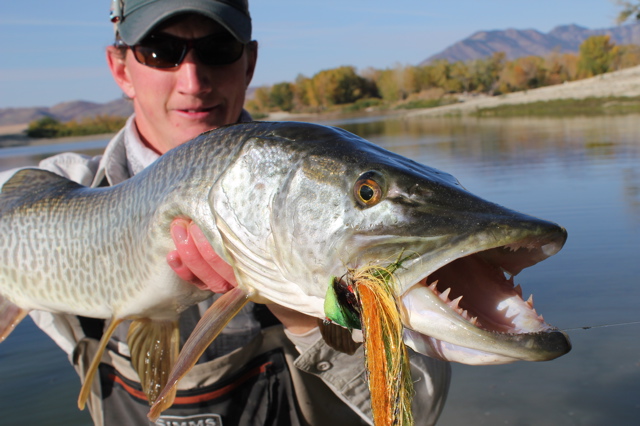
The Musky’s diet can be influenced by a variety of factors including season, water temperature, availability of prey, and the Musky’s size and age.
Musky are known to eat a wide variety of prey, including fish, amphibians, mammals, and birds. Some of the most common prey for Musky include:
- Panfish: Musky are known to prey on a variety of panfish including bluegills, crappies, and sunfish.
- Perch: Yellow perch are a popular Musky prey, particularly in colder water.
- Walleye: Walleye are a favorite Musky meal, particularly in lakes and rivers with a strong walleye population.
- Trout: Musky are known to eat both rainbow and brown trout.
- Bass: Both largemouth and smallmouth bass can be found on the Musky menu.
Lesser known food sources:
- Frogs: Musky are known to eat both frogs and tadpoles.
- Salamanders: Some Musky anglers swear by using salamander-imitating lures to catch these fish.
- Muskrats: Muskrats are a common Musky prey item, particularly in the fall when the Musky are preparing for winter.
- Mice: Small mammals like mice can also be on the Musky menu.
- Ducks: Musky have been known to eat ducks, particularly ducklings.
- Gulls: In some lakes, Musky have been observed eating seagulls that land on the water’s surface.
Overall, Musky are opportunistic feeders and will eat almost anything that they can catch and swallow. Anglers should take into account the specific prey items in the body of water they are fishing when selecting their lures and techniques.
Choosing the Right Lures
One effective strategy for selecting lures is to match the hatch. This means choosing a lure that looks and moves like the Musky’s natural prey in the body of water you are fishing. For example, if the Musky in your lake are feeding on perch, choose a perch-colored lure that mimics the movements of a live perch.
Musky are known to be attracted to lures that mimic the movements of their prey. This can include lures that create a side-to-side wobble or those that imitate the erratic movements of a wounded baitfish.
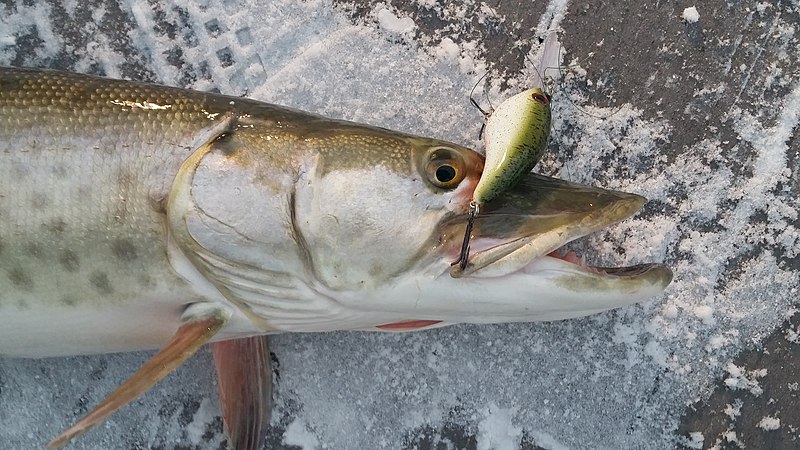
Musky are attracted to bright colors, particularly in murky or stained water. Brightly colored lures, such as those with fluorescent hues, can help attract Musky to your line. In clear water, more natural colors like greens, browns, and blues can be effective.
When selecting lures, it’s important to consider the water conditions, time of day, and season. Experiment with different lures and techniques until you find what works best for the Musky in your body of water.
Fishing Techniques
Musky can be found in a variety of locations including weed beds, rocky points, drop-offs, and other underwater structures. Look for areas with good cover and plenty of prey. Musky are also known to follow schools of baitfish, so pay attention to any activity on the surface of the water.
Presentation techniques:
- Jerkbaits: Jerkbaits are a popular lure choice for Musky anglers. These lures are designed to mimic the movement of a wounded baitfish and can be worked in a variety of ways, including a slow and steady retrieve or a series of quick jerks followed by a pause.
- Topwater baits: Topwater baits are effective for Musky, particularly in the early morning and late evening when the water is calm. These lures can be worked with a steady retrieve or a series of quick jerks to create a splashing or popping noise that attracts Musky.
- Bucktails: Bucktails are another popular lure for Musky. These lures consist of a lead head and a skirt made of deer hair or synthetic material. Bucktails can be worked at a variety of depths and are effective for imitating a wide range of prey items.
When presenting your lure, vary your retrieval speed and technique until you find what works best for the Musky in your body of water. Musky can be finicky and may require a specific presentation to trigger a strike.
Conclusion
In conclusion, understanding what Musky eat is crucial for successful fishing. Musky are apex predators that will eat a wide variety of prey including fish, amphibians, mammals, and birds.
Anglers should take into account the specific prey items in the body of water they are fishing when selecting their lures and techniques. Matching the hatch, mimicking the prey’s movement, and choosing the right color can all be effective strategies for selecting lures.
When presenting your lure, vary your retrieval speed and technique until you find what works best for the Musky in your body of water. With the right approach and a bit of patience, you’ll be well on your way to catching these elusive and exciting fish.
Pike vs Pickerel – What’s the Difference?
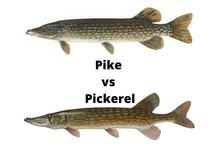
Pike and pickerel are two very similar species that are found throughout much of the North American continent. They are known as some of the most popular freshwater fish species for anglers who fish along rivers and lakes in the upper portion of the United States and Canada.
Many people mistakenly assume that pike and pickerel are the same species. In this article, we’ll explore some of the differences between pike vs pickerel, as well as other information about each species that will help when it comes to identifying each one.
Pike vs Pickerel Overview
Both the pike and pickerel species are fish that belong to the Esocidae family, which includes a range of different pike and pickerel variations, as well as the muskellunge species. Since they are found in relatively the same type of area within lakes and rivers, many people assume that pike and pickerel are the same type of fish.
Also Read: Muskie vs Pike
They share many similarities in their overall appearance and behaviors compared to other types of freshwater fish. Their long, slender body shape is designed to give them extreme levels of speed and acceleration in the water, which helps them chase down and catch small bait fish with ease.
In addition to their body profile and the way in which their fins and tail is oriented to the rest of their bodies, pike and pickerel also have many similarities in the way their bodies are marked and colored.
They each have a darker-green complexion than other freshwater fish with the distinct light-colored markings that are found along the sides of the fish.
What is a Northern Pike?
The northern pike is a peculiar type of freshwater fish species found throughout North America. They have been given the name “water wolves” by biologists and anglers who are familiar with this species due to the fact that they are often found working together in packs to herd and corral their prey and devour them using a group effort.
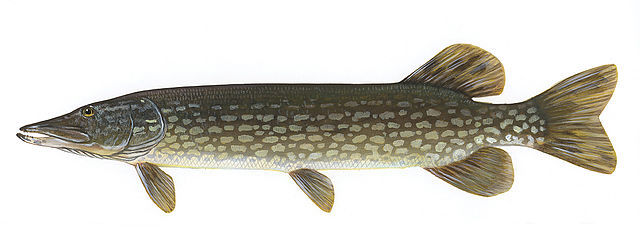
Pike are found in North America, as well as the many freshwater lakes and rivers across Europe and Asia. While the North American pike is known to be one of the larger freshwater fish species in this part of the world, the Eurasian pike is actually much larger and can often grow to sizes of more than 40 pounds in many cases.
Also Read: What Do Pike Feed On?
Northern pike have a distinct long body with a large mouth that is lined with very sharp teeth which they use to grasp or simply devour their prey. Their body color is often dark-green, but some pikes might have darker or lighter color variations depending on the region where they are found.
Most pikes like to live in slow-moving rivers or lakes where the water is relatively shallow. They especially like to stay around weedy areas of lakes and rivers where the water is less than 4 feet in depth as this type of environment is rich with a variety of different types of bait fish, insects and other creatures that pike will eat.
What is a Pickerel?
Pickerel are very similar to the northern pike species in many ways and they actually are usually mistaken as pike in some cases. They are much smaller than both muskies or pikes when the reach full maturity, but even experienced anglers often have trouble distinguishing small pikes from their close cousins, the pickerel.

Pickerel, or chain pickerel, exist in a few different varieties that can be found throughout North America. Their habitat range stretches much further south than the pike or muskie and it’s not uncommon to find pickerel as far south as Florida and throughout the Mississippi River system.
They are very prominent throughout the southeastern United States and are also found all along the rivers and lakes of the states on the East Coast of America, as well as parts of eastern Canada.
The diet of the pickerel consists of mostly smaller fish and insects, but once they reach full maturity, they will prey on fish that might be up to half as large as their own size. Pickerels are opportunistic feeders and will strike at anything from small ducks to crawfish and mice, as well as virtually anything else they get a chance to eat on the water’s surface.
Fishing for pickerel is common throughout most of the United States as these fish are known to be feisty when hooked and will put up quite a fight against an ultralight rod and reel.
They can be caught on a huge variety of lures and baits and many bass anglers or those fishing for crappie and other panfish will often catch pickerel by mistake. Their extremely toothy mouth that’s full of needle-like teeth makes them one of the more dangerous fish to handle without pliers.
Pike vs Pickerel Size
The northern pike is one of the largest freshwater fish in North America, despite the fact that the ones found throughout America and Canada are often smaller in size than their European and Asian counterparts.
These fish commonly grow to roughly 5 or 10 pounds on average and typically measure anywhere from 24 to 32 inches in length. However, there are plenty of instances where they are known to grow to much larger sizes in the right conditions and with an optimal diet.
A trophy-size northern pike is considered to be any specimen that exceeds 20 pounds. It’s actually more common to find bigger northern pike in the far reaches of Canada such as Saskatchewan and the Northwest Territories, as well as Alaska.
The world record northern pike is one that was caught in Europe, but the biggest one ever landed in North America was recorded as being caught in New York’s Great Sacandaga Lake in 1940. The monster fish weighed in at a whopping 46-pounds, 2-ounces and measured more than 52 inches in length.
The average pickerel is known to be roughly 3 pounds and about 24 inches in length. Most anglers consider any pickerel over about 4 pounds to be trophy-size and specimens that are more than 6 pounds are viewed as extremely rare giants.
According to the IGFA, the current world record pickerel was a 9-pound, 6-ounce whopper that was caught in the southern state of Georgia in 1961. There have been stories of 10-pound pickerel in America’s Deep South, mostly because these fish are able to enjoy a warmer climate and longer growing season.
Pike vs Pickerel Differences
Despite the fact that these two fish species very closely resemble one another, there are some reliable methods you can use to tell them apart. Here are the best ways to distinguish a pike vs pickerel.
Color
In many cases, the body’s color pattern and overall shade will be very similar between a pike and pickerel. However, it is true that pickerel will have a more vibrant-yellow coloration to their spots along the sides of the fish’s body.
These spots might appear to be different shades of yellow, but most anglers can distinctly tell that the color of the spots are definitely yellow instead of gray or green.
When it comes to pikes, these spots will usually be a bit smaller, bean-shaped patterns that will have a light-green shade to them. The best way to tell the pike vs pickerel apart is to look for any yellow markings along the side.
Side Pattern
The side pattern on each type of fish, which is referenced above, will also differ between pikes and pickerel. The main difference between pike and pickerel in this regard are that pikes will often have more distinct markings along their sides with clear outlines while a pickerel’s side pattern might fade in and out.
Many pickerel are described as having vibrant yellow ‘spots’ that often have an irregular shape, yet a pike’s spots are usually described as oval or bean-shaped.
Gills and Pores Under Jaw
Most anglers are aware of the fact that northern pike and pickerel have distinct pores underneath their lower jaw. These pores are used to detect prey in many cases, but the specific number of pores on each type of fish can help you distinguish which species you’ve caught.
Northern pikes will usually have 5 sets of pores on either side of their jaw. In some cases, they might have 4 sets or even 6 sets, but the number is never less than 4 sets of pores. Pickerel, on the other hand, will usually have 3 sets or possibly 4 in rare cases.
Conclusion
It’s true that hybrid species exist between northern pike and pickerel, but these are often very difficult to distinguish between either a pike or pickerel.
It’s common for the most experienced anglers to have difficulty telling these two similar species of fish apart, so don’t expect to become a master at distinguishing pike from pickerel overnight.
By using the information we’ve provided in this article, you should have a good foundation for understanding how to tell a pike vs pickerel in your future fishing trips.
Muskie vs Pike – What’s the Difference?
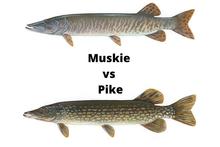
There are few freshwater fish species outside of muskie and pike that are more sought after by anglers. These fish are also the two species that most often get confused for one another.
If you’re one of the many anglers who sometimes can’t tell the difference between a muskie and a pike, we’ve compiled this article to serve as a handy guide for doing so.
Muskie vs Pike
The best method to tell the difference between Muskie and Pike is to look at the tail. Both species have forked tails, however Muskie have a mush deeper v-split in the tail, whereas pike’s are more rounded.
In parts of the northern United States and Canada, muskie and pike are two of the most coveted species of fish that anglers target in the large lakes and river systems that stretch throughout upper North America.
They are both known for their long, powerful frames that allows them to swim with extraordinary speed and agility, which also makes them extremely challenging to land with a rod and reel.
Many beginner anglers mistakenly believe muskie and pike are the same species of fish, but that’s not the case. Though these two common freshwater predators have a lot of similarities, they also have distinct characteristics and behaviors that set them apart.
Pike have been given the nickname “water wolves” by anglers because they are known to hunt in packs and corral their prey before striking. They hunt schools of small bait fish with exceptional ferocity and have large mouths with very sharp teeth.
The muskie are also known to be a vicious predator willing to eat anything they can catch, but they are often referred to as the “fish of a ten thousand casts” due to the difficulty anglers have in catching them.
Muskie and pike are both part of the Esocidae family, which includes lots of pike and pickerel species that are native to North America. These two fish also belong to the same Esox genus within that species, but they do have some distinct differences between one another.
In the following sections, we’ll explain more about these two species in greater detail.
What is a Muskie?
The muskellunge, often known as the “fish of 10,000 casts,” is a species of big freshwater predatory fish endemic to North America. It is sometimes abbreviated to muskie, musky, or lunge. It is the biggest member of the Esocidae pike family.
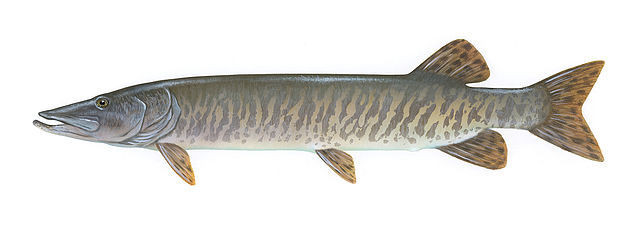
There are a few different strains of muskie that exist throughout different parts of the United States and Canada. Some of these might have darker or lighter color combinations and markings, but they are essentially the same species.
Muskellunge are commonly found in large lakes and rivers throughout the upper Midwest and around the Great Lakes region in states like Michigan, Wisconsin and Minnesota.
Their range actually exceeds the borders of these states and anglers often find muskie as far south as Tennessee and north Georgia and eastward as far as New York and Maine.
In these states, they are often found in great numbers within lakes that have healthy, thriving ecosystems that offer a variety of different food sources. They are known to be ambush predators and have a very quick striking ability which they use to swiftly bite and even devour their prey with one lightning-quick attack.
There is virtually no other fish that muskie won’t eat—including their own kind. Muskies are known to prey upon a huge variety of different types of animals that are usually found around lakes and rivers such as rats, mice, frogs, ducks and insects.
Also Read: What do Musky Eat?
Usually found in areas of shallow water near the shore, although muskies might venture down into deeper waters during the summer or winter.
They are known to spawn during the spring and are considered to be among the most exciting freshwater fish that anglers can catch in North America.
What is a Northern Pike?
The northern pike is a carnivorous fish species in the genus Esox. They are found in brackish and fresh waterways across the Northern Hemisphere. In the United Kingdom, Ireland, and much of Eastern Europe, as well as Canada and the United States, they are simply known as pike.

Northern pike, which are commonly known as pike, have a body shape and profile that is very similar to that of a muskie. They have the same type of elongated body with overly-large mouths that are full of very sharp teeth that are used to bite and grasp larger prey than most freshwater fish will target.
It is this nearly identical body shape and fin structure that makes many anglers confused as to the identity of the fish they might have landed.
These fish tend to vary in their body color with some having a lighter coloration while others might be much more vibrant or darker. Pike are found throughout a much larger section of the North American continent, as well as in vast regions of Europe and Asia.
The Eurasian northern pike are often capable of growing to much larger sizes than the North American variety, but these fish are not what any angler would consider to be small, by any means.
Also Read: Pike vs Pickerel
Pike generally prefer to live in slow-moving water or shallow, weedy stretches of lakes and reservoirs where the water is mostly shallow. Their hunting style is that of an ambush predator as they will often remain very still in the water for long periods and strike with exceptional quickness, devouring their prey in one bite.
Also Read: What do Pike Eat?
They are mostly found in clear water and will spawn during the spring once water temperatures reach 40 degrees in most areas. Pike are very territorial fish and are known to be aggressive toward other pike that might encroach on their habitat.
How Big Do Muskie Get?
Muskie are known to be one of the larger fish in the waters where they are found. The average weight of a full-grown muskie is usually anywhere from 15 to about 35 pounds with anything exceeding this size being considered a trophy-sized fish.
Their length is also something that makes them stand out from other fish species and muskies often grow to be anywhere from 28 to 48 inches with the right diet and habitat.
The world record muskie is recognized as a whopping 69-pound, 11-ounce giant that was landed in 1949 in northern Wisconsin.
How Big Do Pike Get?
The average size for a northern pike is slightly smaller than that of a muskie. Pike often grow to a weight of around 5 to 7 pounds in most conditions and they typically measure 24 to 32 inches in length. However, they are capable of growing to much larger sizes with optimal growing conditions and diet.
The IGFA world record northern pike was caught in Europe, but the largest pike ever landed in North America is recorded as a giant that weighed 46-pounds, 2-ounces and measured 52.5 inches in length. The fish was caught in 1940 in New York’s Great Sacandaga Lake.
Differences between Pike and Musky
1. Color Pattern or Markings
One of the major differences between a muskie and pike are the color markings along their bodies. The muskie typically has different color patterns and will usually be lighter in color than a pike. What is more distinct is the dark black spots or bars that are found on the sides of the muskie, which sometimes appear to be stripes in some cases.
A pike will always have a more dark complexion than a muskie and their overall tone is more olive-colored and distinct. Along with this dark-green coloring will be small bean-shaped spots that are light in color all over the pike’s body.
One of the easiest ways for anglers to tell the difference between muskie vs pike is to observe whether the fish has dark black vertically-aligned bars, or these light-colored spots.
Another point related to their coloration and markings is that the pike’s color pattern and spots will run the length of its body, including the head. The muskie, on the other hand, has markings and bars that run only up to about the gill covers.
2. Tail Shape
One of the other ways you can tell pike vs muskie apart is to observe the shape of the tail. This is often the most reliable way for some anglers to tell what type of fish they have caught.
Both a muskie and a pike will have a tail that’s relatively the same size in proportion to the fish’s body, but there is one slight difference between a muskie vs pike.
A muskie will have a much more pointed tail that also has a slightly deeper V-shaped fork. The tail of the muskie is also known to have black spots on it while the tail of a pike is slightly yellow with dark green mixed in.
The northern pike’s tail is much more rounded than that of the muskie and it will feature a lesser V-shaped fork in its tail as well.
3. Number of Pores
The last method you can use to tell the difference between a muskie vs pike is to look at the fish’s lower jaw. Each type of fish will have holes or pores on the underside of its jaw, but the number of pores is different on a muskie vs pike.
Pike typically have about 4 or 5 of these pores underneath the jaw while a muskie will have at least 7 pores on either side of its lower jaw.
Conclusion
It’s easy to see why anglers love to catch both muskie and pike as they are able to grow to large sizes and put up an immense fight when hooked. Using these identification methods, you should be able to confidently tell what type of fish you’ve caught when fishing for muskie or pike.
Musky Tackle and Gear
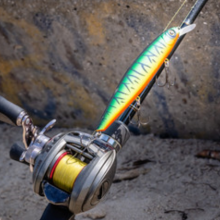
Let’s face it musky tackle is a step above most other freshwater species in terms of size and strength.
With musky and northern pike being some of the biggest freshwater predators available in the USA it stands to reason that most musky gear is usually aimed squarely at these big fish.
Smaller setups are just too light once you start hauling muskie over 15 lbs.
Rods, reels, line and lures are much bigger and usually built to a much tougher standard.
All musky should be released with the utmost care and attention. Large musky in particular can get into trouble when handled aggressively or when out of the water for too long.
One very important reason why you do not want to use light gear or tackle for muskie fishing is that it will take a lot longer to get the musky in your net when on light gear.
The longer you are fighting a big fish the more you will have to tire it out before netting.
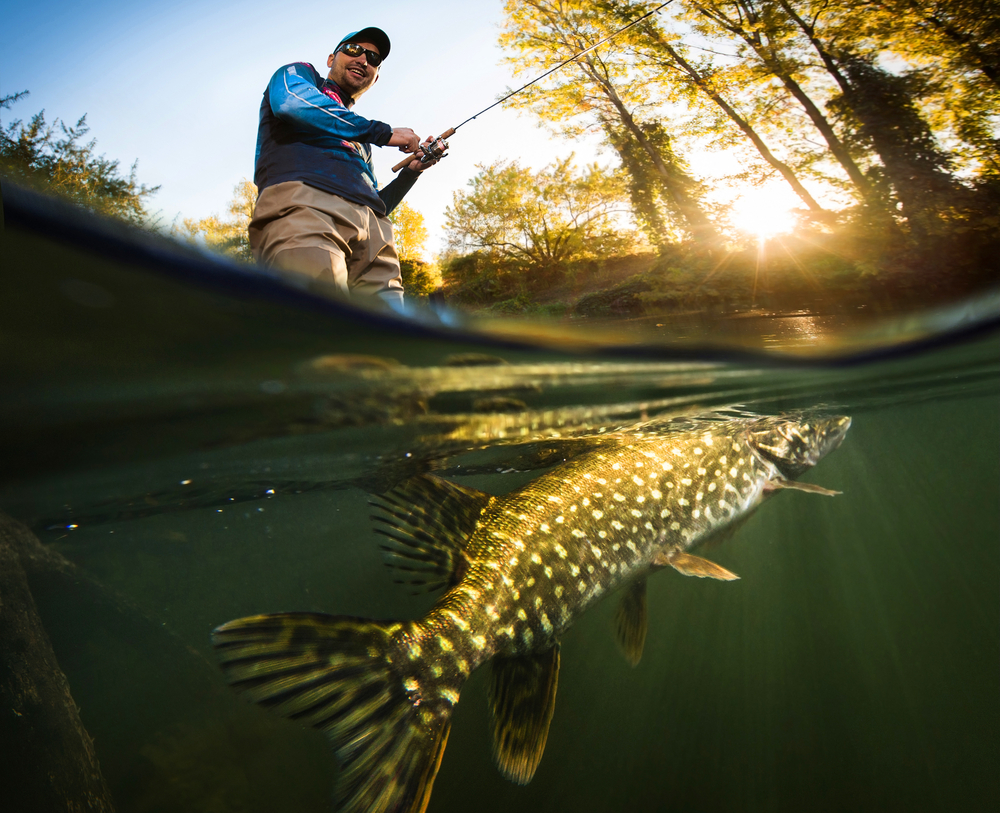
If you know that the pike local to your area do not grow too large you can catch them on a spinning tackle setup.
With heavier gear you can get them in the net much quicker without a prolonged fight.
50 lb braid, heavy or extra-heavy power rods and size 500 baitcaster reels are not uncommon when seeking trophy musky.
Both casting and trolling are popular approaches but so to is using bait in colder months when musky are less active and don’t want to chase a lure.
Musky Tackle
A heavy baitcasting setup will usually be the right choice when casting larger lures all day long.
Obviously if you are trolling then you’ll need a heavy trolling outfit for your boat and a big net!
1. Rods
The majority of musky rods will be roughly 8 to 9 feet long even rising to as high as 9’6″ depending on the type of casting and size of lures you are doing.
That extra length is always a plus when it comes to making long casts on heavier musky gear.
Power wise as we stated earlier you want a rod that is rated heavy or extra heavy.

You need a lot of backbone when musky fishing and lighter rods will strain considerably as too will you.
Action needs to be fast. A fast action allows you to set the hook quickly and it will also mean that you can make snapper casts with heavy line.
2. Reels
The usual size and type of musky reel is a baitcaster in the 300 to 500 range.
Although you can use a spinning setup baitcasters will always be the preferred choice especially if you are targeting really large musky.
The king of all is the Shimano Tranx 500 which is an absolute beast of a reel.
You can use a 300 if you are fishing in smaller lakes where the musky have not grown too big.
A lot of musky will not make big long runs instead they will stay down deep for as long as possible so you need a decent reel to help haul them up from the depths.
3. Line
Braid is normally the order of the day and you’ll be running 50 lb braid for most scenario’s maybe even running as high a 80 lb depending on the type of water that you are fishing.
Wire leader are used extensively and normally connected to your main line by the use of a high quality swivel.
4. Lures
The are a huge range of lures available from spinners, spoons, swimbaits, frogs and spinnerbaits that have caught musky for decades.
The one thing they have in common is size. Ripping large bucktails is one of the best methods for warmer weather musky fishing.
5. Nets
In my mind a net is almost an essential. You really want to minimize the amount of handling that you do to large fish and a high quality net makes life so much easier.
Remember to buy a net with a very large rim diameter as getting caught with a net that is too small is asking for trouble.
Also Read: Pickerel vs Pike
If possible opt for a net that has modern rubber mesh netting.
Old style knotted nets are really bad for fish as the scrap off the fishes natural slime layer that protects them from infection.
A net is an essential part of your musky tackle.
A Good Musky Rod and Reel Setup
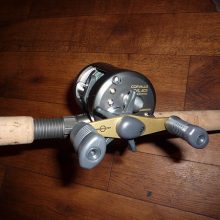
If you’ve decided to try your hand at catching a musky for the first time then you might be aware that a lighter bass or trout setup quite simply isn’t going to cut it.
Let’s face it musky are the largest freshwater predatory fish that most people will probably target.
Unless of course you happen to be lucky enough to take a fishing vacation to some exotic place that have giant river monsters lurking there.
Musky are big;
Really big and you need the right tackle to handle them.
Below we’ll discuss a decent casting setup.
Ultimately the best musky reel that you can afford and the right length rod paired with a strong enough line is the basis for the right musky tackle selection.
Musky Rod and Reel Setup
A good musky casting setup that is a proper balance between reel, rod and line will give you the best results.
A bad pairing of any of those with the others will certainly result in not getting the best possible performance from all of them.
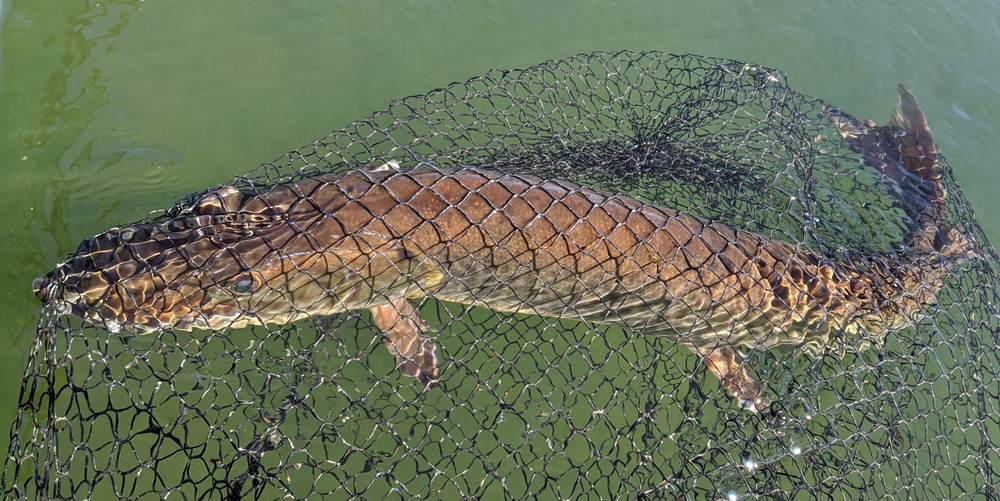
Reel
A musky setup for casting is almost always going to require a baitcasting reel.
Sure a large size 4000 or 5000 spinning reel is strong enough to handle a large muskie but if you are casting all day on a heavy spinning setup it can become really tiring.
A baitcaster gives you the ability to cast one handed. Hit the button, flick the lure out and control with your thumb on the spool.
That being said there is a learning curve to using a casting reel so if you have only ever used a spinning reel then it really is worth taking the time to learn.
Most people fear the dreaded birds nest.
Modern baitcasters have come a long way so don’t be deterred. The best bet is to get someone experienced to show you how to use it.
And yes as a beginner you may get a few birds nests and that may be a little annoying but everyone goes through the same process.
One thing for sure is that once you master the technique are likely to never go back to a spinning setup unless of course you are looking to use really light tackle as that is where it excels.
Rod
The best musky rod will have a heavy to medium-heavy fast action and is the usual the go to choice for musky fishing.
Length wise you should be looking at least a 7’6″ rod. My personal preference is for an 8′ fast action rod with a heavy power rating.
This may be a longer rod than you are used to but it is worth it. The longer rod with larger lures makes for some very long casts assuming everything is matched up right.
Longer casts give you the ability to cover a lot more water in a day. This is something that is often overlooked.
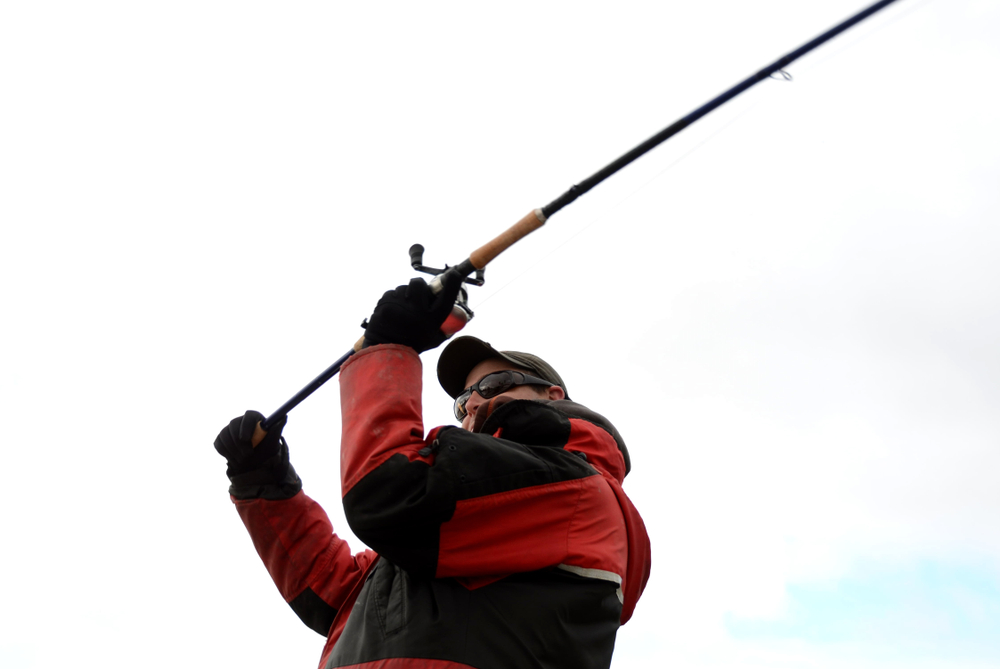
A heavy action rod will have a lot more backbone than a lighter one. Musky are heavy fish and the rod really needs to be up to the job of absorbing a lot of the energy these big fish can put down against you.
The fast action is preferred for a good casting performance. A Fast action rod will start to bend a lot closer to the tip versus a slow action which will begin to bend closer to the reel seat.
Bending at the tip allows you to load the rod blank for a much longer cast. Think of the blank as a spring that is loaded on your back cast. You want all of the power that you put into it to whip the lure out quickly.
The only time you would want a slower or more moderate action is if you were using really large crankbaits.
Line
If you are casting then the go to choice is going to be braid. Especially when using a baitcaster.
Most musky fishermen will opt for braid that is at rated at least 50 lbs . That’s at a minimum. It is not uncommon for those targeting large musky to use 80 lb braid all season.
Braid not only casts well on a baitaster but it has the added advantage of being able to slice through weeds a lot easier than mono. This is due to the diameter being smaller than the equivalent rating monofilament line.
Also Read: Chain Pickerel vs Pike
It also has a lower stretch than mono. A lower stretch in the line mean more precise hook settings and will generally give you a lot more sensitivity.
A quick hook set is important when you are casting long distances with big lures as the longer the line out the slower your hookset will be.
Leader
A big strong wire leader is a must on any musky rod and reel setup.
Take one look into the jaws of a musky and you’ll see row after row of sharp teeth. This teeth will make light work of either braid or mono.
A good wire leader should give you a lot more confidence once the strike comes that the fish will not slice it’s way through your line.
Most wire leaders are bought pre-rigged with a swivel and snap-link, you can always make your own if required as it requires minimal tools to get the job done.
Tiger Musky Teeth
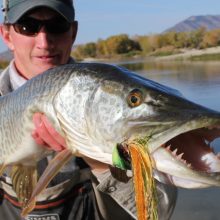
Being one of the biggest freshwater fish in the US it’s of little surprise that a Musky’s teeth are one of it’s most notable features.
With a massive jaw, long torpedo shaped body, and massive rear fin the musky is one of the to predator freshwater species in North America.
If you have ever caught or seen a musky in the flesh then you probably agree that the teeth are some of the biggest and intimidating of anything you are likely to catch in freshwater.
Row after row of sharp teeth adorn it’s mouth with the sharp canine’s that line the outer edge of the jaw being the most impressive.
Muskie fishing line needs to be heavy for a reason and a lot of anglers will use a heavy wire trace as their leader purely because of just how sharp those razor like teeth are.
Musky Teeth
Musky are ambush predators and like all large fish or animals that have evolved to be near or at the top of the food chain in their environment musky have a very well developed set of teeth that are designed for catching prey.
A muskies head has a flat, duck-billed shape that is designed for grabbing it’s prey and then swallowing it head-first.
Each type of tooth performs as specific task.

The main teeth that are used when hunting are the large canines that can be found on the outer rows of both the upper and lower jaw.
A musky will generally ambush smaller fish. As it strikes it can open up it’s large flat mouth a considerable distance giving it the ability to attack larger prey that can be up to 20% of it’s own weight.
Also Read: Northern Pike vs Muskie
The roof of the mouth has mush shorter almost brush like teeth that are used to help grip it’s food as it tries to swallow.
Unlike some other larger saltwater predators such as sharks the muskies jaw and teeth are not designed to take large bites out of it’s food. Instead the teeth are designed only for grabbing.
Once a musky catches it’s prey in it’s canines it will use the rest of it’s teeth to grip the prey and turn it so as to swallow it head first.
It turns it’s food to a head first position as it is easier to swallow this way. And when swallowing smaller fish such as perch and walleye it can flatten down the dorsal fins that contain sharp spines.
How Many Teeth do Musky have ?
This will vary greatly by age and size. Most muskie have probably hundreds of the smaller brush like teeth that they use for gripping it’s prey as the swallow them.
The number of larger canines in the mouth can vary. You can usually find that the much larger older fish will in fact be missing quite a few of their main teeth. They probably break off due to age and use.
It’s not uncommon to find really old musky that are missing a lot of their teeth from the front of the jaw, the smaller brush like teeth do seem to fair better.
Trolling for Musky – Tips & Tricks
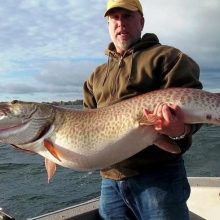
Without a doubt trolling for musky can be on of the most productive ways to cover a lot of water, especially if you are new to the lake that you are fishing on.
Easily the most popular method to catch large muskie at it’s core it’s pretty simple:
Drag a lure behind your boat at the right speed at the right place and depth
Sounds so simple a child could do it.
However there are a few subtleties that can make all the difference between skunking out and landing the tiger muskie of a lifetime.
Trolling for Musky
Most people who troll for musky will generally do so on the edge of a weed bed in a large lake.
This is by far the most popular way to find them and then present them with a lure.
Lure size, location, time of year, trolling speed and depth are probably the most important variables to get right.
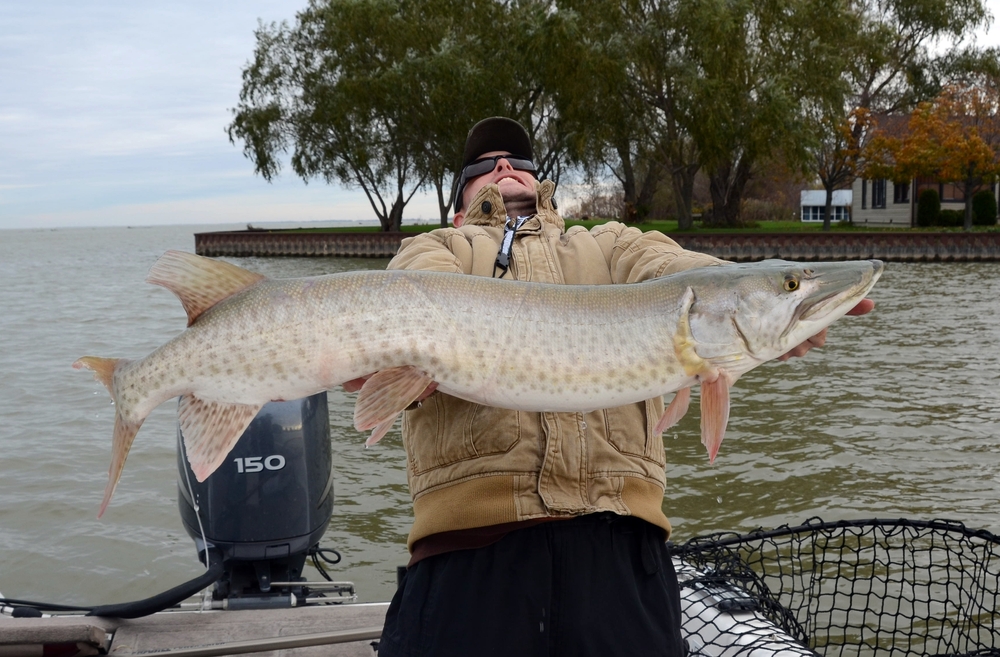
Musky Trolling Tackle
The main tackle is usually a good quality trolling rod for musky, either a conventional or a baitcasting reel and heavy main line such as 80lb paired with a wire leader.
For deeper trolling you may wish to use a downrigger or even lead core line depending on the situation.
Regardless of your setup all musky tackle and gear is much heavier than bass or trout so it’s best to size up your gear to suit them.
Lure Size
Given that they are one of the largest freshwater predators around it is perfectly natural for a beginner to choose as big a lure as possible.
That’s not always the case however and musky have bee known to hit some pretty small crankbaits and swimbaits.
All they need is plenty of shine and a little bit of wobble put in front of them to bring out their inner predator. If a muskie is hungry enough they’ll even hit a plastic worm!
That being said larger lures do tend to attract the larger fish. One nice side affect of using a large lure is that smaller fish are less likely to hit your lure.
Musky Trolling Speed
Although a big lazy muskie will hit a lure that’s just being twitched on the water surface most people do prefer to troll somewhere in the range of about 2-10 miles per hour:
- 2-4 mph – in shallow waters and in cold waters
- 4-6 mph – most popular speed for muskie
- 6-10 mph – usually in warm summer months
Of course the depth and type of lure that you use will have a huge impact on the speed at which you troll.
Location
Muskie are mostly ambush predators and given their markings it’s easy to see why they favor weed beds and other dark structures that can help to camouflage them from their prey.
Given their size they do tend to stay out a little bit deeper than say a pike would but they will still generally both patrol and lie in wait along the deeper edges of larger weed beds.
Also Read: Pike vs Muskie
In summer months they can be found in shallower waters and some will actually spend a few hours motionless quite close to the surface sunbathing during the summer heat.
Time of Year
Mushy tend to stick to two different locations and that is usually dictated to as to the time of year and the temperature.
In spring/summer months they will tend to move towards the shallower waters and the temperature is around 60 degrees.
In the winter months they will move to the deeper waters at about 40 degrees.
Musky Trolling Depth
As mentioned above the time of year has a big impact on the depth that you will find muskie.
Trolling along the edge of a weed bed using a fish finder is by far the most consistent way to troll where the fish are.
However you can also target the bigger fish in much deeper waters. You’ll need some specialist tackle to get your lures down deeper than they are designed to swim such as:
- Downrigger
- Planer boards
- Lead core lines
Everyone has there preference as to which one to use personally I will always favor a downrigger as I believe it gives the best possible control of the depth that your lure is swimming.
Best Musky Reel 2023 – [Buyer’s Guide]
![Best Musky Reel 2023 – [Buyer’s Guide]](https://www.lakeontariooutdoors.com/wp-content/uploads/2018/07/best-musky-reel-220x220.jpg)
Make no mistake about it big muskies require a super powerful rod and reel setup.
A musky reel is a completely different piece of engineering than a regular reel you might use for bass or trout.
And with good reason;
These large freshwater predators are built for the kill and with fishermen commonly taking fish up to 30 lbs and beyond they pack a mean punch once hooked.
Even a smaller adult musky in the 10 to 15 lb range is capable of giving regular freshwater spinning gear a real beating.
That’s why you need a heavier musky rod and reel in one of the following varieties:
- Baitcasting – A baitcasting reel paired with a good heavy fast action casting rod.
- Trolling – A trolling reel used with heavy trolling rod usually with either a down-rigger or lead core lines for targeting muskies when they are lying deep.
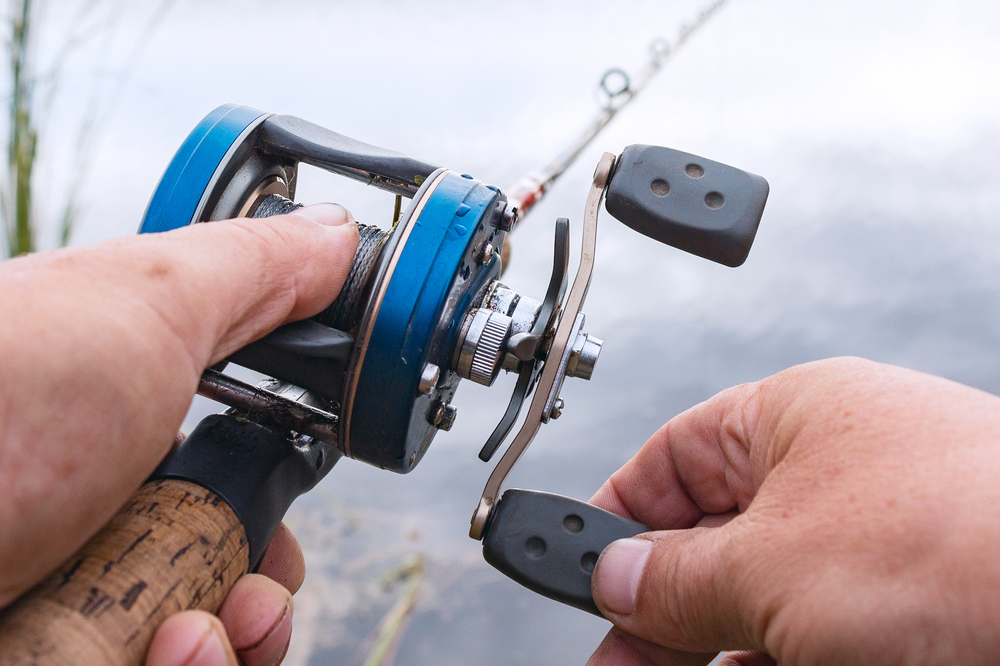
Although quite a few people will troll for musky especially if the are running deep, the preferred tackle is a baitcasting setup.
A good baitcaster for musky has got to be capable of handling lots of heavy line usually in the range of 50 to 80 lb braid and have a drag rating of 20 lbs minimum although you may get away with a reel with a drag of 15 lbs.
Types of Reels for Musky
Most anglers should be familiar with the three types of reels that are available for freshwater use:
- Spincast Reel – not suitable for musky
- Spinning Reel – not the best option for musky
- Baitcasting Reel(and to a lesser extent conventional reels) – top choice
All the reels share a few common attributes i.e the line is wound around the spool by the turning of the handle. They all also have some for of drag mechanism that can be adjusted and will also have some method or design that will allow you lure to be cast out.
However, they differ greatly in their usages. Understanding how each reel works and what it is suitable for is the first step in deciding what kind of reel you need for musky.
If you’ve never fished before you may not be familiar with the following types of reels so here is a brief introduction to them as why they are or are not good choices as reels for musky fishing.
Spinning Reels for Muskie
Spinning reels for muskie are a serious step up in terms of strength and performance over a spin cast reel.
A spinning reel using a bail arm that winds the line around the spool as you retrieve the lure. To cast you simply flip the bail arm open, hold the line with your index finger, swing the rod and release the line as the rod is pointing forward.
More to it than casting a spincast reel and not as difficult as a baitcasting reel.
Spinning reels are usually chosen by those that are using very light lures on ultralight tackle. Most freshwater spinning reels would not be suitable for using for muskie.

They are generally to light and the drag is not strong enough to handle a large 30 lb musky as it runs away from you with it’s nose down in the weeds.
You can of course use a heavier saltwater spinning reel.
Although these heavier spinning reels(in the appropriate sizes) will be more than capable of handling a musky they have one major drawback in that the weight of them will make casting all day very tiresome.
Casting large lures over and over as you try to cover a lot of water is not a lot of fun with a big, bulky and heavy spinning reel.
Another drawback is that if you choose a spinning reel you are also limited to the types of rods you can choose.
Spinning reels rarely work well on a baitcasting setup as they need the eyes lower down close to the reel to be large so as to accommodate the circular motion of the line as it comes off the spool during casting.
Baitcast Reels for Muskie
Without a doubt the preferred choice of reel for muskie fishing is a baitcasting reel.
Most muskie fishermen will opt for a level wind baitcasting reel as it will generally give the best casting performance and is also mush easier to use than a regular baitcaster.
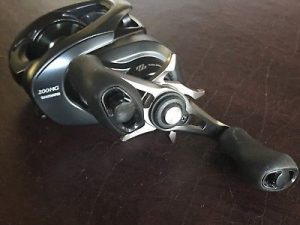
The level wind feature is a small guide that move across the spool as the spool moves. It ensures that the line is laid on the spool in an even manner.
Reels without a level wind require the user to use their thumb to guide the line across the spool as you retrieve.
A baitcaster blends all of the best attributes you would want in a reel:
- Line capacity
- Tough drag
- Higher gear ratio’s
- Well built
Some fisher men will shy away from a baitasting setup as they think it is too difficult to learn how to cast a baitcaster.
Although there is a specific knack to it with a little practice it shouldn’t take long to learn how to throw a lure with these reels.
In fact once you learn how you’ll regret not having done it sooner.
Although best is always subjective below you’ll find a list of the top musky reels available on the market.
The Tranx 500 is one monster of a baitcasting reel and can do practically anything you may ever need. However it is a little on the pricey side and there are others that are cheaper and perform almost as well.
The Daiwa Lexa and the Okuma Komodo are both very popular mid-priced reels and are the go to for the average muskie fisherman. So if you are on a budget then these are the ones to go for.
Best Musky Reels
1. Shimano Tranx 500
The Shimano Tranx 500 is considered the ultimate musky reel if you want to throw large lures a long distance and have enough line capacity and drag power to land just about anything.
There are two models in the series:
- TRX500HG – High speed model
- TRX500PG – High power model
The TRX500HG has a whopping 43″ of line retrieval for every crank of the handle thanks to a 6.6:1 gear ratio. If you are looking to retrieve lures quickly this is a serious contender and is on of the best musky reels for burning bucktails.
The TRX500PG is a real power house with it’s 4.6:1 gear ratio offering a lot more torque, that extra power does result in a loss of retrieval speed as you would expect down to 30″ per crank
Both models have a 25lb drag that is more than enough for any muskie. With an all metal construction the reel housing is super stiff and suffers from very little flex even under very high loads.
Line capacity is big. In fact for a baitcasting reel it exceptional. Both the TRX500HG and the TRX500PG can hold up to 420 yards of power pro braid.
With the Tranx you get all of the casting ease of a baitcasting reel and the line capacity of a conventional reel.
Casting is extremely slick thanks to the VBS breaking system. VBS is a departure from the more common magnetic breaking system found on today’s baitcasters.
Instead of magnets it uses centrifugal force to apply more pressure at the start of the cast which is where there is a higher probability of backlashes.
The break weights lessen their pressure on the spool as it begins to slow towards the end of the cast. This allows it to spin more freely when you want it most.
The only major negative to the Tranx 500 line is the price if you are on a budget then this really isn’t the best option. However, if you are looking for what is effectively the Ferrari of the musky fishing world then the Tranx is the best muskie reel for the money hands down.
Specifications
- S A-RB shielded bearings
- VBS break system
- Dartainium II Drag
- Super speed spool
2. Abu Garcia Revo Toro Beast
The appropriately named Revo Toro “Beast” from Abu Garcia most certainly lives up to it’s name.
Available in two sizes a 50 and 60 model it is second only to the Tranx 500 in terms of hauling large musky. Although it is a slower reel in terms of retrieval speed than the Tranx it makes up for it in brute strength and pulling power.
For each size there are two available retrieve ratio’s:
- 4.9:1 – 23.5″ retrieve per crank
- 6.2:1 – 30″ retrieve per crank
The exact amount retrieved per turn will of course depend on which handle you opt to use and how much/diameter of line you are using.
All editions are available in either a left or right hand versions giving a total number of eight different variations available.
The Beast is built for a combination of casting performance and retrieval power.
It comes with two power handles that are fairly simple to swap out. A longer handle gives you a lot more torque so if your game is hauling heavy baits in search of trophy musky then it is preferred over the shorter handle.
The max drag rating is 25 lbs and uses Abu’s Carbon Matrix Drag System which gives a super smooth drag performance that remains consistent even under full pressure.
Specifications
- 7 HPCR stainless steel bearings
- Power Stack Carbon Matrix Drag System
- InfiniMax braking
- Power or Casting handle
- Aircraft grade aluminum spool
3. Daiwa Lexa 300/400
Both the Lexa 300 and 400 from Daiwa are what’s described as low profile baitcasting reels. Unlike smaller reels for bass fishing the 300 and 400 models are high capacity and are capable of holding a large amount of high diameter line.
On the 300 for example you can hold about 240 yards of 40 lbs braided fishing line.
They come equipped with an all aluminum spool and MagForce cast control ensuring a smooth spool speed all the way through the casting range.
The “Ultimate carbon drag” provides up to 22 lbs of pressure which is pretty considerable for a low profile baitcasting reel.
Specifications
- MagForce cast control
- Aluminum spool
- Ultimate carbon drag
- 22 lb drag presure
4. Okuma Komodo SS
Ultra-low profile baitcasting reels were once reserved for much smaller capacity sizes but the times are changing. The introduction of the Komodo SS from Okuma coincided with lots over other offerings in the 300 and 400 sizes being released by all of the major brands.
Essentially a newer, larger version of the well received but little known Komodo 364P(still available).
The SS gets upgraded to all stainless steel hence the ‘SS’ in the name. The main gear, spool shaft, drive shaft and pinion gear are now all heavy duty stainless steel.
The spool, frame and side plates are all made from high quality machined aluminum.
Depending on the size you opt for the Komodo comes with either six or seven HPB High Performance stainless steel bearings.
The drag is made from high output carbonite and is capable of a max force rating of 30 lbs which is one of the highest you will find on a low profile baitcaster musky reel.
Specifications
- 30 lbs max drag
- Carbonite drag(multi disk)
- Heavy duty stainless steel internal components
- Machined aluminum spool and frame
5. Shimano Tranx 300/400
If the Tranx is just too big for your needs then the smaller 300 and 400 sized models are a great alternative if you are not hunting massive muskie.
The Tranx line up has replaced the much loved Curado series that was quite popular for many years as an all round musky fishing reel.
There are currently eight different models available across the 300 and 400 sizes.
- 300A – 5.8:1 gear ratio(right handed)
- 301A – 5.8:1 gear ratio(left handed)
- 300AHG – 7.6:1 gear ratio(right handed)
- 301AHG – 7.6:1 gear ratio(left handed)
- 400A – 5.8:1 gear ratio(right handed)
- 401A – 5.8:1 gear ratio(left handed)
- 400AHG – 7.6:1 gear ratio(right handed)
- 401AHG – 7.6:1 gear ratio(left handed)
So you effectively have a choice of a 300 or 400 in left or right handed version and also with a high or a low geared ratio.
The low gear ratio 5.8:1 has a 30 inch retrieve per turn of the handle and the high gear 7.6:1 has a 40 inch retrieve per turn of the handle.
Of course the line capacity will be lower than on the Tranx 500, with the 300 model holding up to 190 yards of 50 lbs power pro braid and the 400 model holding 170 yards of 65 lbs.
Note: these reels have a lower max drag of about 18 lbs
Specifications
- Super rigid Hagane body has minimal flex
- HEG oversized gears
- 5+1 S-ARB stainless bearings
- Variable centrifugal braking system
6. Okuma Coldwater Line Counter
The Okuma Coldwater series of trolling reels have been a massive hit with freshwater fishermen whether that’s for large lake trout of hunting walleye deep down on the great lakes it comes as no surprise that they make a great musky trolling reel.
There are seven models to choose from, the DLX variations are left handed ones and there are three of those available.
The Coldwater are a very low maintenance trolling reel and have a self lubricating gear system.
Built with trolling specifically in mind the internal gears feature a mechanical stabilizing system which helps eliminate flex and warping under extreme loading.
Specifications
- Multi disc carbonite drag
- Great value line counter
- Gearing system is self lubricating
- Can take lead/copper lines
Musky Reels
Muskie along with catfish are the two species of freshwater fish that require the use of heavy fishing reels that are capable of housing a large capacity of heavy braided fishing line.
As stated early your best choice is probably going to be a low profile baitcasting reel in the correct size.
If you are only used to spinning reels then the thoughts of casting with a baitcaster for the first time can be a little unnerving.
But fear not;
It is not that difficult to learn how to cast a baitcaster. With a little practice and perseverance you be amazed just how quickly you get the hang of it.
In fact once you make the change you’ll regret not having doing it earlier.
Having the ability to toss a lure with the flick of the wrist will mean a lot more accurate casts and it will also mean less arm fatigue as the day wears on.
Shimano Musky Reels
Shimano have established themselves as one of the top reel manufacturers in the world. They have earned a lot of trust from fishermen by producing some of the most innovative and high tech reel available.
If you are looking for a Shimano musky reel then there are a number of options available on the market:
- Shimano Calcutta D
- Shimano Tranx 300/400
- Shimano Tranx 500
- Shimano Tekota
Personally Shimano are my go to brand for reels and have been for many years whether that’s on the hunt for large muskie or throwing small Rapala’s on ultralight gear for trout.
Cheap Musky Reels
Muskie reels are generally built to a very high specification and as with a lot of things in life you will generally get what you pay for.
Whatever about your rod purchasing a cheap reel is a recipe for disaster. A cheap musky reel is probably going to fail once it is put under any kind of real pressure.
A large muskie that keeps it’s head pointed down into a reed bed once hooked is going to put a huge strain on the drag of any reel and low quality components will usually mean one thing:
A seized up reel and a musky still on the hook
You are probably best staying away from any reel that is under a $100 as the quality and durability quite simply won’t be there.
Best Musky Rod 2023 – [Buyer’s Guide]
![Best Musky Rod 2023 – [Buyer’s Guide]](https://www.lakeontariooutdoors.com/wp-content/uploads/2018/07/best-musky-rod-220x220.jpg)
Hauling large muskies on a light rod quite simply isn’t going to cut it.
If you’ve ever snagged a muskie on bass tackle you’ll know that all that extra weight can put some serious strain on a light/medium power rod.
One kick from that massive tail is enough to make a regular baitcasting setup almost bend in two.
At the end of the day targeting large musky requires specialist gear that is up to the job of handling these powerful fish.
Choosing the best musky rod for your setup depends on just how exactly you intend on fishing.
With the right rod and reel combo you should be able to handle even the largest of musky.
Lets take a look at just what kind of tackle you can use.
The following three methods are the most popular types of gear that you can catch muskie with:
- Baitcasting – used to make pin point accurate castings of lures that vary in size,weight and diving depth.
- Trolling – Trolling for musky will usually be done when you want to target fish that are deep down on large lakes
- Spinning – spinning is probably the least used of any configuration when fishing for muskie. It can be quite good when using natural bait fish on a rig.
By far the most popular rod setup used for musky is a baitcasting setup. The gear will usually fall somewhere in the following ranges depending on the lure being used:
- Rod – 7-1/2 to 9 feet in length, heavy to extra heavy power and usually fast action
- Reel – Musky reels are usually baitcasters of varying retrieval speeds
- Line – 20 to 80 lbs usually braid
Length
Muskie rods will usually be between 7.5 and 9 feet in length of course if you are trolling you run several different length rods depending on your boat setup.
A longer muskie pole gives you that little bit extra casting distance so you can cover a bit more water throughout the day.

A longer pole will also help to a lot of the energy out of the fish as you are playing then as the long pole will help to absorb some of the power as the fish run away from you.
A sweet spot seems to be in and around the 8 foot mark. Be aware that some of these longer rods unless they are in a two piece can be a pain to transport around and to store in your garage.
Some of the brands will have their longer rods as telescopic or collapsible. Usually they will break down to less than 7 feet in these cases.
Power
Heavy powerful fish require a rod with a lot of back bone. The rod blank will take a hammering when you are playing a big muskie.
Sometimes the bigger fish can take almost an hour to land without snapping any of your gear. Which means your rod needs to be able to handle a lot of pressure on it for an extended time period.
At a minimum you will want to choose a rod that has a heavy power rating at the lightest. At lot of guys will opt for an extra heavy power rating especially when casting really heavy lures.
Action
A good action to use is going to be fast. A fast action gives the rod a lot more backbone.
A fast action means that the bend in the rod will happen much further up the rod blank. This gives the rod a lot more backbone and means you can firmly set the hook in a muskies tough mouth.
A faster action will also allow you to whip the lure out giving a better casting performance.
With a fast action you end up loading the top section of the rod more unlike a slow action where the rod will start to bend closer to the reel seat.
This ‘action’ combined with a long rod allows you to use the weight of the lure to store a lot of energy in the rod blank as you cast, as you release that energy is used to throw the lure further distances than you would normally get on slower/shorter rods.
Best Musky Rods
1. St Croix Mojo Musky
If I could only pick one brand from which to buy a musky rod it would have to be St Croix.
Although the Tackle Industries brand(shown lower down) is certainly a top contender they are however pretty hard to come by and your local tackle shop may not have them available.
The St Croix Mojo line has built a huge following in the bass world, this muskie edition has also lived up to the other lines reputation.
St Croix offer two musky specific rods the Mojo Musky and the Legend Tournament Musky rods. With the Legend Tournament being the higher end rods and are priced accordingly.
Built using the now legendary St Croix SCII graphite blend they are extremely durable and some with two coats of Flex-Coat slow cure finish.
A Fuji TCS reel seat keeps your reel securely fixed in place. The main rod guides are Kigan Master Hand 3D with aluminum oxide rings and black frames.
The top guide is also a Kigan Master but uses a SiC ring.
They come with a split grip cork handle.
Looks wise they really stand out from the crowd with a very striking purple finish on both the blank and the decals.
The range features rods from 7’2″ up to 8’6″‘ in length and a variety of power and actions available. The most popular models would be the 8’ or 8’6″ in either a HF(heavy/fast) or a XHF(extra heavy/fast)
Probably the best musky rod for the money. A solid performer that is significantly cheaper than some other models on the market and they come with a 5 year warranty.
Specifications
- SCII graphite rod blank
- Kigan Master Hand 3D guides throughout
- Fuji TCS reel seat
- 5 year warranty
2. Abu Garcia Veritas Toro
The Veritas Toro is probably Abu Garcia’s most popular Musky rod. It is a no frills well built alternative to the St Croix rod above and is usually priced in and around the same level.
It is designed to withstand the stresses of musky fishing from the bottom up. A rod blank that is built from 30 ton graphite for lightness and sensitivity is reinforced with Abu’s “Sublayer Armour” for extra strength.
The handle is high density EVA and the guides are stainless steel with Zirconium inserts.
Altogether a well built rod that is aimed at inshore casting or musky these rods are real workhorses and can take quite a beating.
Specifications
- 30 ton graphite
- Reinforced fibers
- EVA handle
- Stainless steel guides with Zirconium inserts
- Limited 3 year warranty
3. Tackle Industries XH
Although most fishermen won’t have heard of Tackle Industries before venturing into the wonderful world of Muskie fishing, they have built a solid reputation as the go to musky specialist rod range.
The only major drawback to the brand is that availability can sometimes be a issue. Usually they can be found in specialist tackle shops that cater to muskie fishing or occasionally in online stores.
This is a 9′ rod that is actually telescopic and reduces down to 7’6″ for easier transport.
This rods are specifically built for throwing large muskie lures in the 2-8 ounce range and are suitable for line ratings in the 60-130lbs range.
Specifications
- 9′ rod reduces down to 7’6″
- Split grip handle
- EVA grip
4. Okuma Helios
Not everyone is going to be casting big lures in pursuit of specimen muskie. On many smaller lakes you do find that muskie will only grow as big as the lake will allow them to. In other words only if there is a really big supply of food will they grow to monster sizes.
Saying that you might only want a rod that is to be used for muskie that are all under 15 lbs or there about. If that is the case then a slightly smaller rod might be suitable.
The Helios listed here from Okuma is a 7’6″ rod with a heavy power rating. It’s a pretty light rod so if you are covering a lot of ground all day whilst casting from the shore on a smaller lake then it can be a lot less tiring than some thing a bit more beefy.
Specifications
- 40 ton carbon fiber
- ALPS guides with zirconium inserts
- Limited lifetime warranty
5. Daiwa Accudepth Trolling
Trolling is the best way to target larger muskie that are living down in the depths in larger lakes. A good muskie trolling rod needs to be able to handle constant strain on it.
There are a few different techniques to trolling such as using down-riggers, lead core lines and weight either on a three way rig or as inline weights.
Each method does can need a specialty rod especially when using down-riggers. The model shown above is suitable for use with down-riggers as it has a slow action.
This Accudepth rods from Daiwa are surprisingly cheap considering how well made and durable they are. Lots of backbone and yet still has a pretty decent amount of sensitivity.
Specifications
- Graphite Composite rod blanks
- Aluminum oxide cut proof guides
- Foam grip
Musky Rod Buying Guide
Although we have mentioned length, power and action above there are some other important considerations to take into account before you purchase a rod for muskie fishing.
Firstly lets do a recap on what was discussed earlier:
Rod Length
Rod length plays a significant role in both how you use a rod and in it’s power.
For most applications a good fishing rod for muskie will generally fall into the range of between 7.5 feet and 9 feet in length.
Trolling rods for musky can be on the shorter end of this range whereas a baitcasting rod for musky would be in the higher end of the range.
There is some what of a sweet spot somewhere in the middle.
Surprisingly even a small difference of six inches to a foot can have a dramatic influence over not only how the rod feels but also how much backbone it has and just how good the casting performance will be.
Smaller freshwater fish like bass or trout will rarely require need a rod of more than seven foot. Musky rods however need to be able to cast much heavier lures long distances and they will also need to be able to handle much heavier line.
As a general rule of thumb a longer rod will cast further and will also be more accurate than a shorter one.
A longer rod length also gives you a lot more control once you hook into a large muskie. It’s much easier to land a larger fish on a long rod than on a shorter one. That being said it is still possible to land a monstrous muskie on a short rod.
Rod Power
Make no mistake about it bigger fish require a rod blank that has a lot of backbone. Fighting a large muskie for a long time will put a huge amount of stress one your rod.
Shorter rods with a light power rating will quite simply not be up to the job and some in fact may even snap resulting in a lost fish and lure.
A heavy power rating is the order of the day. Don’t be alarmed if you are used to using lighter rods for smaller species you can still get very accurate casts thanks to the increased rod length.
Rod Action
Rod action is one of those things that is sometimes misunderstood by quite a few people.
A fast rod action means that the rod will start to bend much higher up on the blank. Whereas a slow rod action will start to bend much closer to the handle.
A faster action allows you to load the top section of the rod much more easily when casting.
With a slower rod action you need to work a load harder to whip the lure out to it’s maximum distance.
Loading the top section stores the energy of the back swing in the top of the rod like a spring. When you whip it forward all that stored energy will transfer into the forwards increasing the speed of the lure just as you release it.
Rod Handles
Because a musky fishing rod is usually a lot longer than other freshwater species you will almost always find that there will be a long split handle.
Smaller spinning rods and baitcasting rods can sometimes have a single piece handle usually in cork.
On longer muskie fishing poles however you will almost always find a split handle.
The longer split handle allows you to control the back swing of your cast a lot easier. On longer rods this is a must especially when using very heavy lures.
The longer rods also require quite a bit more muscle to load the rod blank. Having a longer split handle gives you a much better mechanical advantage as you can use the extra long handle as a better lever.
Ultimately the choice of rod handle is usually a personal one as it rarely affects the performance of the rod.
Cork
Cork handles are still pretty common on a lot of high quality rods. Cork is a well proven material on fishing rods and it also can add to the look of the rod significantly.
The only problem with a cork handle is that it does tend to have some durability issues especially as it gets older.
Foam Grip
Foam grips are both light and very comfortable to use. They are nice to hold even all day long and do tend to age better than a cork handle. They are also a lot less absorbent than a cork handle so they can be a little easier to keep clean.
Reel Seats
Quality reel seats are a must especially when tackling larger fish.
However they are often an element that are overlooked. If you stick to any of the big name brands you will mostly find that they use a good reel seat.
Fuji are by far the biggest name in both reel seats and rod eyes and if you rod has a Fuji reel seat you can probably be assured that it is a very high quality one.











